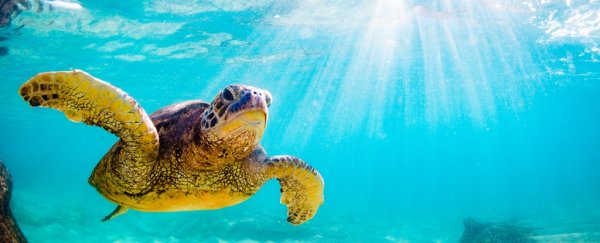It's not often humanity gets to pat itself on the back for a positive effect on the environment, but researchers are hailing sea turtles as a "global conservation success story" as population numbers climb.
Six of the seven species of sea turtle are at varying threat levels on the International Union for Conservation of Nature Red List of Threatened Species. But research shows significant improvements that show promise for the future.
Humans have not been kind to turtles. They have been killed for their shells and meat, and their eggs harvested for food. Their nesting and foraging habitats have been destroyed, and they get tangled in fishing nets, or caught accidentally.
The hawksbill turtle and the Kemp's ridley turtle are both critically endangered, the green turtle is endangered, the loggerhead turtle, the leatherback turtle and the olive ridley turtle are all vulnerable. Only the flatback turtle isn't listed as threatened, but there's insufficient data for an assessment.
To gauge turtle numbers, the research team studied data on 299 nesting sites, monitored between 6 and 47 years. They found that 95 of those nesting sites had significantly increased numbers of nests, compared to just 35 that had significant decreases.
The team isn't 100 percent sure what's causing the upward population trend, but believes it's linked to protection of eggs - harvesting them is illegal in many countries, and heavily restricted in others.
There's also been a reduction in sea turtle bycatch, thanks to initiatives such as the development of a fishing hook that is much less likely to be swallowed by the turtles.
However, that doesn't mean the sea turtle is out of the woods, or even close. The researchers found that leatherback turtles continue to decline.
There are other factors that need to be taken into account, too. Counting the nesting sites before the eggs hatch will not include potential disasters affecting juvenile turtles.
Rising sea levels at Raine Island in Australia, the world's largest remaining green turtle nesting site, has killed many eggs before they could hatch, since the eggs can't survive underwater.
Many loggerhead turtle hatchlings died at Mon Repos in Australia earlier this year when sand temperatures became too hot for survival.
Sea turtles take a long time to reach sexual maturity, too. Hawksbill turtles take 3 years, loggerhead turtles take 12 to 30 years, and green turtles take anywhere between 30 and 50 years to sexually mature, so population rises we're seeing now could be thanks to conservation efforts some time ago.
Saving the sea turtles will continue to be an ongoing effort.
"Our findings highlight the importance of continued conservation and monitoring efforts that underpin this global conservation success story," the researchers wrote in their paper.
The research was published open access in the journal Science Advances.
